Nashville, TN - October, 2002
Updated: 11/22/08
Because
of the large number of photographs, this page will load slowly.
Note: All photographs on this page are thumbnails - permitting you to
view a larger image by clicking on the thumbnail using your left mouse button.
To
return to the original page, click on the "back arrow" on your
browser.
Historic Homes
The Hermitage Plantation - Home of Andrew Jackson
Belmont Mansion
Belle Meade Plantation
Travellers Rest Plantation
The Hermitage Plantation - Home of Andrew Jackson
The first stop on our bus tour of historical homes was The
Hermitage. This completely restored mansion features many of the original
furnishing and fixtures. And, it includes nearly all of President and Mrs. Jackson's
personal effects.
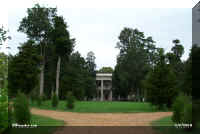 The
drive is lined with cedar trees. Some from when Andrew Jackson planted
them. Others were put in to replace those lost to a tornado in 1998. Our guide reminded us
that the small trees were like the ones that would have been on the property when
the Jackson's lived there.
The
drive is lined with cedar trees. Some from when Andrew Jackson planted
them. Others were put in to replace those lost to a tornado in 1998. Our guide reminded us
that the small trees were like the ones that would have been on the property when
the Jackson's lived there.
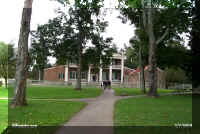
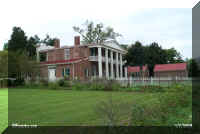
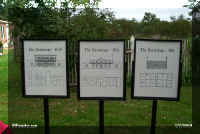 When
Andrew and Rachel Jackson moved to The Hermitage in 1804, they occupied
several log cabins and outbuildings. In 1819 Andrew began construction of a
brick Federal style home. In 1831 he added two wings and a colonnade to the
house. Some of the improvements were damaged by fire in 1834. The Greek Revival
facade was completed during the 1836 renovation that followed the fire.
When
Andrew and Rachel Jackson moved to The Hermitage in 1804, they occupied
several log cabins and outbuildings. In 1819 Andrew began construction of a
brick Federal style home. In 1831 he added two wings and a colonnade to the
house. Some of the improvements were damaged by fire in 1834. The Greek Revival
facade was completed during the 1836 renovation that followed the fire.
The property has been preserved by The Ladies' Hermitage
Association since 1889. Visitors are encouraged to take photographs of
the grounds but photographs are not permitted of the inside of the mansion. So, we have
no interior photographs. You'll have to go and see the inside of the mansion for
yourself.
The Greek
inspired tomb, located in a corner of the garden, was built for Rachel in 1831.
Andrew was buried beside
Rachael in 1845. The family cemetery was next to the tomb.
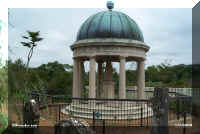
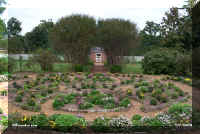
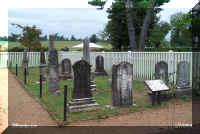
The Hermitage property ranged in size from 425 acres at its
purchase in 1804 to 1,000 acres in 1845. The chief cash crop was cotton. The
farm was nearly self-sufficient by growing most of its own food.
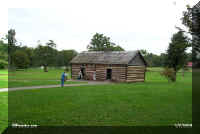 Documentation suggests Jackson treated his slaves with
care -- a population of about 140 in the 1840's. He
encouraged a stable family life and supplied them with adequate food and housing.
African Americans were involved in all aspects of life at The Hermitage and
performed a wide range of
tasks. Slaves
were entrusted with the care of the Jackson's children and trained Andrew's prized
racehorses.
Documentation suggests Jackson treated his slaves with
care -- a population of about 140 in the 1840's. He
encouraged a stable family life and supplied them with adequate food and housing.
African Americans were involved in all aspects of life at The Hermitage and
performed a wide range of
tasks. Slaves
were entrusted with the care of the Jackson's children and trained Andrew's prized
racehorses.
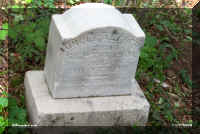 One slave who remained
after emancipation was Alfred. He
served the Ladies' Hermitage Association as the guide to the property in the
1890's. He is buried in the garden near the family cemetery.
One slave who remained
after emancipation was Alfred. He
served the Ladies' Hermitage Association as the guide to the property in the
1890's. He is buried in the garden near the family cemetery.
A visit to The Hermitage is worth your time.
* * *
* *
Belmont Mansion
The second stop on our bus tour was at the Belmont Mansion. To our bus
driver's surprise, the tour
guide was a friend of hers. The guide was energized as he told us the history of
Adelicia Acklen and the mansion. He gave us an in-depth tour.
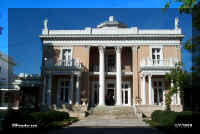 The
Belmont is an ornate Italian villa built in the 1850's as a summer home for
Adelicia, one of the wealthiest women of the mid-19th century. After being used
as various schools since 1890, it has been part of the campus of Belmont
University since 1951. Belmont
was placed on the National Register of Historic Places in 1971.
The
Belmont is an ornate Italian villa built in the 1850's as a summer home for
Adelicia, one of the wealthiest women of the mid-19th century. After being used
as various schools since 1890, it has been part of the campus of Belmont
University since 1951. Belmont
was placed on the National Register of Historic Places in 1971.
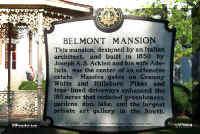
The house contains thirty-six rooms with approximately 10,900 square feet of
living space and an additional 8,400 square fee of service area in the basement.
The house is filled with fine furniture, paintings, and original statues by
American artists. Four of the five major marble statues remain in the
house today.
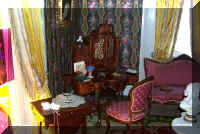
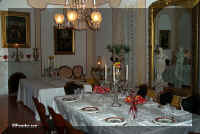
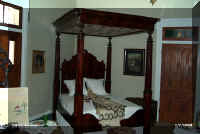
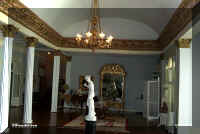
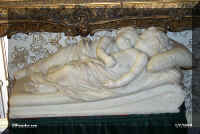
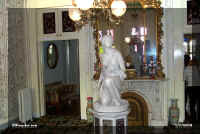
These photographs show Adelicia and the Belmont estate in its
early days. It is
interesting to note that Adelicia opened the 180 acre estate for the citizens of
Nashville, as there was no public park available.
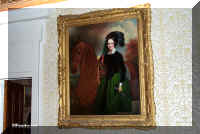
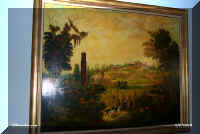
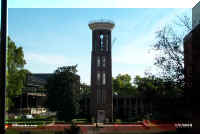 Adelicia
was socially connected to officers on both sides of the Civil War. It permitted
her to conduct business in Tennessee, Louisiana and England during the
war.
Adelicia
was socially connected to officers on both sides of the Civil War. It permitted
her to conduct business in Tennessee, Louisiana and England during the
war.
As a result of these connections, this water tower was occupied by both the
North and the South at different times during the Civil War. It made the
observation of approaching enemy troops possible.
The tour of the Belmont Mansion was very interesting. Unlike the other
historic homes where there are other buildings to investigate, you can walk to the
water tower but the rest of the property is used as the college campus.
* * *
* *
Belle Meade Plantation
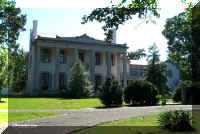 This
Greek Revival mansion was originally the centerpiece of a 5,400
acre working plantation and thoroughbred horse farm. It was built in 1853
by General William G. Harding (son of John Harding). Today, the mansion and
surrounding 30
acres are listed in the National Register of Historic Places.
This
Greek Revival mansion was originally the centerpiece of a 5,400
acre working plantation and thoroughbred horse farm. It was built in 1853
by General William G. Harding (son of John Harding). Today, the mansion and
surrounding 30
acres are listed in the National Register of Historic Places.
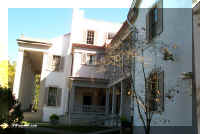
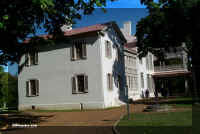
The reputation of Belle Meade as a stud farm began in 1816. After the Civil War,
John's son, Confederate cavalry General W. H. Jackson, brought
the mansion to world prominence as a thoroughbred nursery and stud farm. It was
the home of Iroquois, the first American bred horse to win the English Derby.
Linage of some of today's top racehorses can be traced to this stud farm. The
entrance hall is lined with pictures of the some of the horses raised on the
plantation.
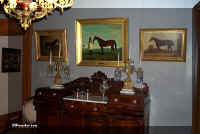
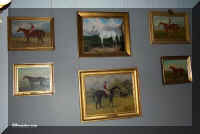
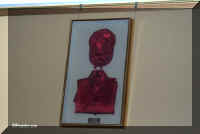 These are the
'racing silks' that identified who owned the horse. In the early days of horse
racing, colors were used instead of numbers to identify the owners.
These are the
'racing silks' that identified who owned the horse. In the early days of horse
racing, colors were used instead of numbers to identify the owners.
This
curved staircase is a prominent feature of the mansion.
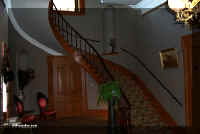
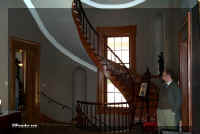
First to second
floor
Second to third floor
The rooms
were full of period furniture and decorations - very well done. Notice the copper water heater,
cook stove and sink in the 'modern' kitchen.
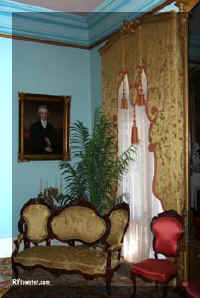
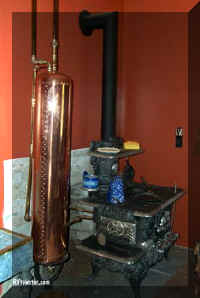
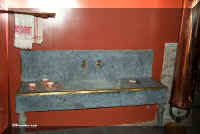
The 1890 Carriage House and Stable features one of the largest
collections of antiques carriages in the South.
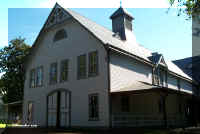
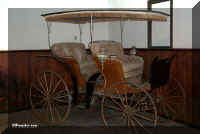
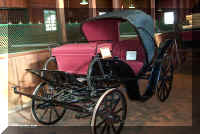
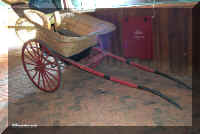
This governess's carriage was used
to take the children around
the plantation.
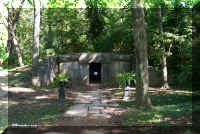 A path behind the house
leads to the Mausoleum.
A path behind the house
leads to the Mausoleum.
The
mansion was not the first house on the property.
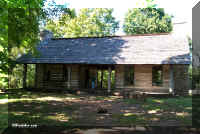 When
he moved from Virginia in 1807, John Harding
bought a 1790 log cabin known as Dunham Station, a trading post along the Natchez
Trace. It was located on the property on which Belle Meade
was built. He lived in the cabin while he developed the stud farm business. The cabin was
nothing like the house his son built in 1853.
When
he moved from Virginia in 1807, John Harding
bought a 1790 log cabin known as Dunham Station, a trading post along the Natchez
Trace. It was located on the property on which Belle Meade
was built. He lived in the cabin while he developed the stud farm business. The cabin was
nothing like the house his son built in 1853.
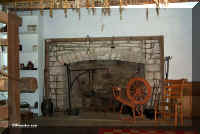
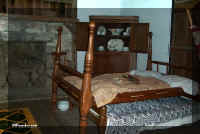
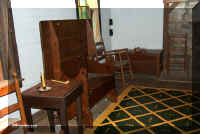
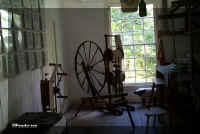 John brought several slaves with
him from Virginia. By 1850, the Hardings were
the fourth largest slave holders in the county with 93 slaves. By
1860, that number had reached 136. There is a lot of information provided about the slave population
at Belle Meade. This photograph shows (left wall) the framed information about slaves know to be at Belle Meade
in 1860.
John brought several slaves with
him from Virginia. By 1850, the Hardings were
the fourth largest slave holders in the county with 93 slaves. By
1860, that number had reached 136. There is a lot of information provided about the slave population
at Belle Meade. This photograph shows (left wall) the framed information about slaves know to be at Belle Meade
in 1860.
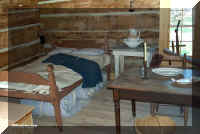 Living
conditions for the slaves were comparable to other plantations in the
area. The cabins were saddlebag style duplexes with single brick chimneys
in the center. Two families resided in each cabin.
Living
conditions for the slaves were comparable to other plantations in the
area. The cabins were saddlebag style duplexes with single brick chimneys
in the center. Two families resided in each cabin.
The cabins were arranged on three sides of an open court on a
five acre plot. The cabins
housed approximately 60 families- one family per 16 X 16 foot
room. The open court served as a playground for the children and a
place for open air church meetings on Sunday. The 13th amendment emancipated 125
of the 136 slaves. Some of the freedmen continued to work under contract
at Belle Meade for $12 a month, but most moved off the plantation.
Belle Meade Plantation is a property of the Association for the
Preservation of Tennessee Antiquities. It is another historic home worth
your time to visit. We were there over two hours.
* * *
* *
Travellers Rest
Plantation
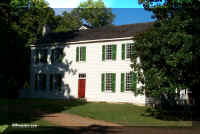 This
home was built in 1799 by John Overton, a law partner and presidential advisor for Andrew
Jackson. It started as a four room house and was later expanded
to 13 rooms.
This
home was built in 1799 by John Overton, a law partner and presidential advisor for Andrew
Jackson. It started as a four room house and was later expanded
to 13 rooms.
Photographs were not allowed inside the house.
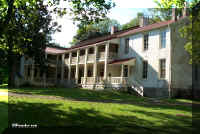
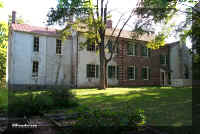
The house contained Tennessee-made furniture from before 1840. It was a haven for
travelers. John Overton encouraged friends and family
to visit often. The bedrooms were set up to sleep a maximum number of people -
including trundle beds.
There are several outbuildings on the property.
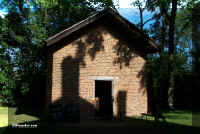
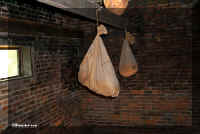
The smoke house.
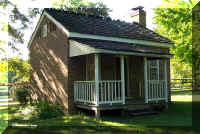
Mr. Oberton's law office
Visitors to the Travellers Rest Plantation begin their visit with a short
video about the history of the house and the family that lived there. This
home was interesting and gave a different perspective than the others. It
was smaller, less lavish that the other properties we visited.
We enjoyed our visit. However, if you have limited time, this one would
not be a 'must see'.
Top of Page
Nashville, TN 2002
Nashville - Grand Ole Opry

 The
drive is lined with cedar trees. Some from when Andrew Jackson planted
them. Others were put in to replace those lost to a tornado in 1998. Our guide reminded us
that the small trees were like the ones that would have been on the property when
the Jackson's lived there.
The
drive is lined with cedar trees. Some from when Andrew Jackson planted
them. Others were put in to replace those lost to a tornado in 1998. Our guide reminded us
that the small trees were like the ones that would have been on the property when
the Jackson's lived there.













































